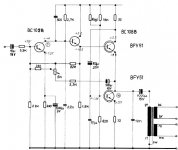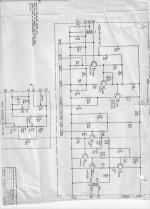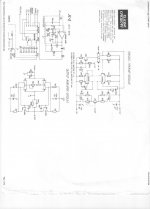ABX is much different than that, and you know it.
Yes, that was his point. Your "peeking" method avoids having to use your actual hearing for evaluation.
I presume that everything except ABX as defined by you or your associates is "peeking". Sorry, I don't buy it.
I presume that everything except ABX as defined by you or your associates is "peeking".
You presume incorrectly, but you already knew that.
This so called "Neve preamp" actually is a standart 3 transistor topology that could be found in 90% of gear from that era and most of you have heard it zillion of times. Want to go back to '70s transistor sound? Fine. Not me.
Bashing first generation op-amps at the same time is counter-productive.
As to the Mr.Neve himself - yes, he is very bright guy, especially when it comes to console architecture/design, but do not forget that he still has horse in this race and his current income depends on number of people in his "church".
"The all-new, discrete amplifiers ... have not only been designed to eliminate crossover distortion and switching transients, but their high voltage design also greatly improves dynamic range, headroom and frequency response."
Crossover distortion? In any half-way decent piece of equipment? In 2014? Give me a break!
Rupert Neve Designs – Evolution
Bashing first generation op-amps at the same time is counter-productive.
As to the Mr.Neve himself - yes, he is very bright guy, especially when it comes to console architecture/design, but do not forget that he still has horse in this race and his current income depends on number of people in his "church".
"The all-new, discrete amplifiers ... have not only been designed to eliminate crossover distortion and switching transients, but their high voltage design also greatly improves dynamic range, headroom and frequency response."
Crossover distortion? In any half-way decent piece of equipment? In 2014? Give me a break!
Rupert Neve Designs – Evolution
Last edited:
Xover distortion does exist, but it is masked by feedback to turn into another form of distortion. It HAS to be there, the output stages of most IC's are STARVED for current. Just add a buffer and listen.
It would be nice to add some data to show at what idle and load the push-pull output stage of the preamp goes to AB, i.e. Xover distortion may exist.
For 10k load, 10Vp output voltage, only 0.5mA idle current is requested for class A operation.
For 10k load, 10Vp output voltage, only 0.5mA idle current is requested for class A operation.
Last edited:
THD is the normalized combination of the harmonic spectral components, so if you're concerned about individual harmonics then by definition THD is the wrong measure.
The THD rises greatly above 1KHz if you use a high source impedance, and loading the output increases it a bit.
I'm glad this circuit was brought up, it seems useful to study considering it's reputation. One thing that sticks out to me is the phase and RF behavior. In modern days I don't think anyone would accept such a result, because of what we've learned about stability compensation and RF behavior.
The THD rises greatly above 1KHz if you use a high source impedance, and loading the output increases it a bit.
I'm glad this circuit was brought up, it seems useful to study considering it's reputation. One thing that sticks out to me is the phase and RF behavior. In modern days I don't think anyone would accept such a result, because of what we've learned about stability compensation and RF behavior.
PMA, how could you know anything in detail about the audio quality of the '60's or 70's?
You were behind the 'iron curtain'. Most of the recordings that I treasure were made from the 60's and 70's. I was out there mastering rock and classical music. Where were you?
You were behind the 'iron curtain'. Most of the recordings that I treasure were made from the 60's and 70's. I was out there mastering rock and classical music. Where were you?
For the record, this particular Neve circuit that I put up, was very early. Just a little later, probably in the USA first, we added complementary small signal devices that gave us even better performance.
This is a typical Ampex line amp schematic, although the input transformer was usually optional. This is mid 60's, before the time that I actually worked there. However, I have made dozens of mastering quality tapes from circuits like this, and at the time, only really high quality tube circuits could beat them. Remember they are essentially Class A in operation, and they are not really OP AMPS. This is important.
Attachments
There are a few dozen 3/4 transistor circuits like this used in professional applications like the one above, and in single ended form, in commercial hi-fi. Mullard has a famous series of app notes with disc equalizers, input buffers etc as well.
There may have been a case 40 years ago to have said these sounded better than the 741, but no longer. The tide turned with the 5532/4 in the late 70s. And, opamps have not stoped getting better, while transistors have pretty much not changed.
Input noise and bias currents now better the best discrete circuits, and you have to go to heroic configurations to beat them on noise. PSRR is orders of magnitude better than discrete circuits.
But of course, none of these these will apparently ever better a Curl discrete design . . .
Interestingly, as I type this, a damn Burson opamp AD has popped up at the bottom of the page.
There may have been a case 40 years ago to have said these sounded better than the 741, but no longer. The tide turned with the 5532/4 in the late 70s. And, opamps have not stoped getting better, while transistors have pretty much not changed.
Input noise and bias currents now better the best discrete circuits, and you have to go to heroic configurations to beat them on noise. PSRR is orders of magnitude better than discrete circuits.
But of course, none of these these will apparently ever better a Curl discrete design . . .
Interestingly, as I type this, a damn Burson opamp AD has popped up at the bottom of the page.
PMA, how could you know anything in detail about the audio quality of the '60's or 70's?
The recording engineer for Fleetwood Mac called me (a while ago now) to tell me that he rewired their console with AD744's for their HBO special. They were quite happy with the sound. I know these exceptions to the usual hegemony don't matter, but hey they happen.
I hear Prince is fond of my 8-legs too, more fond of certain 2-legs though 😀.
Oh, but the DESIGNS changed 40 years ago to better than IC designs.
John, do you really have NOTHING new to say!!!
You guys are still at 40 years ago, when it comes to actual circuit topology. Only IC processing improvements let you get as far as you have today, and I can still beat it, with modern designs.
- Status
- Not open for further replies.
- Home
- Member Areas
- The Lounge
- John Curl's Blowtorch preamplifier part II


